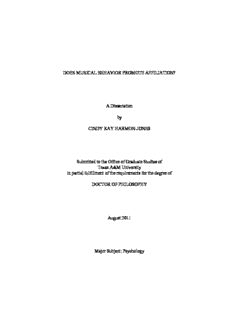
does musical behavior promote affiliation? PDF
Preview does musical behavior promote affiliation?
DOES MUSICAL BEHAVIOR PROMOTE AFFILIATION? A Dissertation by CINDY KAY HARMON-JONES Submitted to the Office of Graduate Studies of Texas A&M University in partial fulfillment of the requirements for the degree of DOCTOR OF PHILOSOPHY August 2011 Major Subject: Psychology Does Musical Behavior Promote Affiliation? Copyright 2011 Cindy Kay Harmon-Jones DOES MUSICAL BEHAVIOR PROMOTE AFFILIATION? A Dissertation by CINDY KAY HARMON-JONES Submitted to the Office of Graduate Studies of Texas A&M University in partial fulfillment of the requirements for the degree of DOCTOR OF PHILOSOPHY Approved by: Co-Chairs of Committee, Brandon Schmeichel Gerianne Alexander Committee Members, Aaron Taylor Jeffrey Winking Head of Department, Ludy T. Benjamin August 2011 Major Subject: Psychology iii ABSTRACT Does Musical Behavior Promote Affiliation? (August 2011) Cindy Kay Harmon-Jones, B.S., Excelsior College; M.S., Texas A&M University Co-Chairs of Advisory Committee: Dr. Brandon Schmeichel Dr. Gerianne Alexander Past research suggested that greater rhythmic complexity in musical behavior increases affiliation in small groups. The current research tested the hypothesis that musical behavior including melody would promote affiliation. In the current experiment, a video showed models either singing nonsense syllables in unison or speaking identical syllables in synchrony. Participants were assigned to either imitate, or merely listen to, the videos. Participants perceived both the synchronous speaking condition and singing conditions as musical behavior. In the imitate conditions, synchronous speaking produced more affiliation and ingroup favoritism and less embarrassment than singing, whereas in the listen-only conditions, affiliation, ingroup favoritism, and embarrassment did not differ between singing and speaking. Reported happiness and fun were greater in the imitate conditions. The successfulness of imitation, coded by judges, was less, and self-reported difficulty was greater, in the singing condition compared to the synchronous speaking condition. Ratings of success at imitation were positively related to affiliation, positive iv affect, and ingroup favoritism. Ratings of success were also related to the average trait approach motivation, agreeableness, and emotional stability of the groups. The results partially supported the hypothesis that musical behavior promotes affiliation. However, performance of the sound-making task was much worse in the singing condition than in the synchronous speaking condition. Because melody was confounded with failure at the sound-making activity, the effect of melody on affiliation is difficult to interpret. Future research should examine the effect of melody on affiliation when melody is not confounded with failure. v DEDICATION To the members of the Mood Elevators, Brandon Schmeichel, Philip Gable, and Eddie Harmon-Jones, thank you for the many happy hours we spent playing music together in our garage band. You inspired and “field tested” the ideas examined in this research. vi ACKNOWLEDGEMENTS I would like to thank my advisor, Brandon Schmeichel for his support. I appreciate your encouragement to pursue an area of research about which I am passionately interested. Thank you for the many hours we spent discussing the ideas explored in this manuscript. I could not have wished for a kinder or more supportive advisor and friend. I also thank my husband, Eddie Harmon-Jones. Your expertise in designing experimental tests of hypotheses was invaluable. Thank you for your helpful suggestions for designing and carrying out this research, and for reading and commenting on drafts of the manuscript. I have the deepest appreciation for your unwavering support during our 21 years together. I greatly appreciate the congregation of the Unitarian Universalist Church of the Brazos Valley, where I served as music director from 2005 to 2011. Your community was a wonderful place to make music along with accomplished musicians in an atmosphere of kindness and love. You allowed me to experience the power of music to bond people together in a practical way. Brandon, Eddie and Philip Gable also gave me a tremendous gift by playing with me in our garage band, The Mood Elevators. You provided a compelling field test of affiliation through musical behavior, and gave me a whole lot of joy. vii I owe a great debt to the research assistants who acted as models in the video stimuli, ran participants, and processed and coded data. Thank you, Kara Polansky, Melanie Felmet, Jessica Edwards, Sarah Eisenbraun, and Sylvia Harmon-Jones. I also thank my committee, Gerianne Alexander, Jeffrey Winking, and Aaron Taylor for many helpful ideas and suggestions. Dr. Alexander encouraged me to consider the nature of music more deeply. Dr. Winking contributed expertise from the field of Anthropology. Dr. Taylor provided advice on statistics for dependent data. I appreciate the gift of your valuable time to serve on my committee. viii TABLE OF CONTENTS Page ABSTRACT .............................................................................................................. iii DEDICATION .......................................................................................................... v ACKNOWLEDGEMENTS ...................................................................................... vi TABLE OF CONTENTS .......................................................................................... viii LIST OF FIGURES ................................................................................................... x LIST OF TABLES .................................................................................................... xi CHAPTER I INTRODUCTION ................................................................................ 1 II MUSIC ................................................................................................. 3 Hypotheses regarding the origin of music ...................................... 4 Functional theories of the evolution of music ................................ 6 Social bonds and music .................................................................. 7 III AFFILIATION ..................................................................................... 10 Endorphins: Neurotransmitters that promote bonding ................... 12 Studies of human affiliation ........................................................... 13 Affiliation and dissonance reduction .............................................. 14 Affiliation and costly displays ........................................................ 17 Costly displays reinforce group values .......................................... 19 Affiliation and affect ...................................................................... 20 ix CHAPTER Page IV SYNCHRONY, MUSIC AND AFFILIATION ................................... 22 Musical motivation and affiliation .............................................. 22 Synchronous behavior increases bonding ................................... 23 Rhythmic musical behavior promotes affiliation ........................ 26 Effects of singing ........................................................................ 27 Reactions to singing in unselected individuals ........................... 31 V DISSERTATION STUDY ................................................................... 33 VI METHOD ............................................................................................. 36 Participants .................................................................................. 36 Video stimuli ............................................................................... 36 Procedure ..................................................................................... 36 VII RESULTS AND DISCUSSION .......................................................... 40 Preliminary analyses ................................................................... 40 Group level tests of hypotheses ................................................... 41 Relationships between task success, group traits, and responses to musical behavior ..................................................... 45 Individual level tests of hypotheses ............................................ 47 Definitions of music .................................................................... 50 VIII GENERAL DISCUSSION ................................................................... 51 IX CONCLUSIONS ................................................................................ 57 REFERENCES .......................................................................................................... 58 APPENDIX ............................................................................................................... 69 VITA ......................................................................................................................... 72
Description: